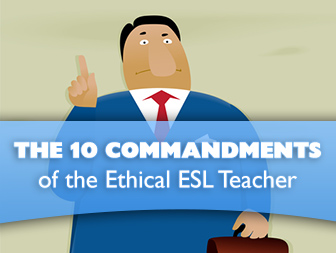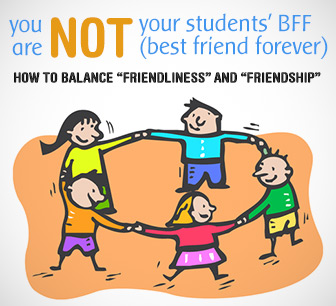The 10 Commandments of the Ethical ESL Teacher


ESL students are often alone in this country and hungry for friendship; teachers, because of the nature of their all-encompassing work, may be similarly lonely. In addition, ESL students have often led interesting lives and have much to say, and teachers tend to be good listeners. So a friendship may blossom, and when the invitation, usually from the student, comes to meet at a local cafe, or to come to the student’s home for dinner, it seems natural to accept. However, there are a number of reasons not to, not to cross that line from teacher to friend.
The first and foremost reason is you are quite simply not your student’s friend. As with parents who try to be their children’s friend but quickly find that they can’t be friends and remain effective parents—your BFF, after all, doesn’t tell you what time to come home or to clean up your room—it’s also very difficult to be your student’s friend and maintain your teacher’s role. After enjoying your student’s hospitality at her home, for example, how do you then give her a “D” on the midterm, even if earned? If you’ve confided in your student your family problems, can you really face her in class, telling her which group to work in and what activities to do? Students do not usually engage in blackmail, of course, but matters do become complicated when the line between teacher and friend is blurred, so it’s best not to blur the line. Of course, this is easier said than done, especially when students do make overtures of friendship. How can these politely be refused? How can you still then maintain a “friendly” relationship without being “friends”? It’s a delicate balance but it can be accomplished.
The teacher really sets the tone for the student-teacher relationship and the overall class. If the teacher is polite, friendly but businesslike, and remains focused on class work rather than personal lives, this goes a long way to establishing a tone. True, sometime a strong-willed student can undermine the tone set by the teacher, but that becomes very hard to do if the instructor has worked on the tone from the first day of class. The lone hostile student sitting in the corner and rolling his eyes or smirking is not so attractive to join if the instructor’s engaging and carefully planned activities are the alternative.
If there is enough to do in class, enough meaningful activities and practice in and outside of class, students will be too focused on learning English to plan their next party with you. It’s fine to have fun with your students, but it’s best to confine that fun to the classroom and educational activities.
Even with careful planning, there will still be students who test limits by attempting to bring in their own personal lives or ask the instructor about hers. The instructor can set boundaries by asking students to talk about their personal lives or share pictures with classmates after class rather than taking up class time passing them around. To questions about her own life that may seem too intimate, the instructor can respond with a smile, “I don’t discuss my personal life in class,” so that it is seen as a general policy, related to teacher, and not directed at a specific student. This can also be followed up with a small joke such as “I’m afraid it might put you to sleep.”
As with most interactions with others, straightforwardness is usually best as people are notoriously poor at picking up on subtle clues and hints. It’s best that you are honest about the kind of relationship you want with your students: one of mutual respect and learning, for example—but inside the class.
Try to maintain a professional demeanor with students. This implies some distance, politeness, and a focus on the intellectual over the emotional side. This is really necessary in effective planning of lessons and grading of students. The focus should be on acting as a teacher not as a buddy.
Finally, be there for your students on campus—in and outside of class. This means not only in teaching class but in advising which classes to take next term, writing letters of recommendation, assisting in understanding assignments, and discussing future professional and educational goals. If students see everything you can do for them as their teacher, they will forget about having you as a “friend.” Friends and teachers help in very different ways and ultimately perform different roles.
It’s all right for students to bring their personal issues to you to help with—how to resolve a problem with a roommate, for example, or how to balance a social life and school life. These are issues that teachers generally have experience in and can offer help with. But the relationship is really not mutual, and that is why teachers really can’t be a student’s “friend”; because a student shared with me her concerns with her roommate does not mean I am free to share my marital issues with her. Just as a parental role really precludes that kind of “sharing,” so does a teacher’s, and just as parents might want to protect their children from the sometimes brutal adult life, so does a teacher want to preserve her classroom space from the ugly outside world. One way to do this is by preserving the teacher-student relationship.
What is your position on teacher-student friendships?